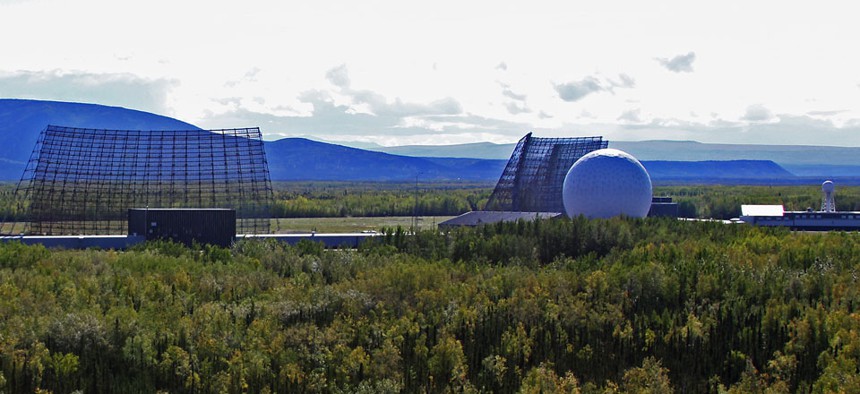New Radar Sought by Congress Likely Would Be Fielded in Alaska, Sources Say

Early warning radar dot the landscape at Clear Air Force Station in Alaska. United States Missile Defense Agency
Defense bill calls for another X-band radar system to help counter a nuclear attack.
A powerful new radar that Congress wants the U.S. military to acquire would likely be fielded in Alaska, according to informed sources.
The compromise defense authorization bill worked out by House and Senate negotiators includes a requirement that the Pentagon's Missile Defense Agency deploy another X-band radar system aimed at helping defend the United States from any potential intercontinental ballistic missile attack by North Korea.
The Defense Department policy-setting legislation, which the House passed on Thursday and now awaits a final vote by the Senate, would authorize $30 million in new monies to initiate deployment "at a location optimized to support the defense of the United States homeland," reads the draft text.
The likeliest place to host the radar is somewhere on the West Coast, say multiple Capitol Hill sources and others.
"My understanding is they are going to put a down-payment on building a long-range radar that would most likely be based near the Clear Air [Station] to cover a good part of the globe, including all the way down to Hawaii," said Riki Ellison, chairman of the Missile Defense Advocacy Alliance.
The Air Force base is located some 80 miles southwest of Fairbanks, Alaska. Its mission for decades has been to monitor for possible long-range missiles fired at the United States.
"There's no other place to put it," said a Senate Republican aide. This source and others provided comment anonymously for this article because they were not authorized to speak on the record.
The United States presently deploys an AN/TPY-2 radar, using X-band technology, at the Shariki military base in northern Japan that monitors for signs of possible ballistic missiles fired by North Korea. A second early-warning AN/TPY-2 unit is slated for fielding by fall 2014 at the Kyogamisaki air base on Japan's western coast.
However, that type of radar is not powerful enough to provide the kind of detailed tracking and targeting information needed to initiate a missile-intercept response to protect the homeland, according to Ellison.
The envisioned radar would be "much more powerful than the AN/TPY-2" and could "be used both as a targeting and early-warning radar," he said.
The military also currently fields the Sea-Based X-band Radar 1 -- a powerful floating radar that can detect small objects in outer space as far away as 2,500 miles and track ballistic missiles throughout the entire course of their flight. The radar was repositioned this past spring to better monitor for North Korea missile attacks during a period of heightened tensions with the Kim Jong Un regime.
However, the sea-based radar is not designed to provide "persistent" tracking information of the kind wanted for around-the-clock awareness of North Korea, according to Ellison. Additionally, the floating radar in future years may need to be relocated to the Atlantic Ocean if the Iranian missile threat becomes more pressing, he said.
The GOP aide said an additional X-band radar is something the Missile Defense Agency wants in order to improve the effectiveness of the country's Ground-based Midcourse Defense system.
The Missile Defense Agency declined requests to comment on the matter, including on whether it assesses a military requirement for having yet another radar monitoring North Korea.
The GMD system presently is composed of 30 long-range interceptors located in silos in California and Alaska, along with supporting X-band radar technology. It is the military's primary defense against a possible North Korean ICBM attack on the continental United States.
A 2012 National Research Council report concluded the GMD system was "fragile" and noted particular concerns with its ability to seamlessly monitor and track ballistic missiles and their warheads during all phases of flight.
The decision this past spring to eliminate the Precision Tracking Space System -- an MDA program that would have placed satellites in outer space to provide near real-time tracking data on launched ballistic missiles -- meant it became all the more urgent to do something that would fill the void in GMD system tracking abilities, Ellison said.
Improving the GMD system's radar capabilities is "equally as important as modernizing the Ground-based Interceptor," Ellison said.
It could take roughly three years for the new radar to be operationalized, according to Ellison and the GOP staffer.
The bicameral defense authorization bill also includes a provision requiring the Missile Defense Agency to be ready by 2019 to deploy on the Eastern seaboard "sensor" capabilities that would monitor for possible ICBM attacks from Iran. That timeline would be sped up should Tehran successfully flight-test a long-range ballistic missile before 2019.
The GOP aide said the Republican side of Congress wanted to have sensor capabilities readied on a shorter time scale to track Iranian threats. However, because the North Korean missile danger is seen as "more imminent," the decision reached by Senate and House Armed Services committee negotiators was to prioritize deploying a radar to monitor the North, the staffer said.
NEXT STORY: Battle Heats Up Over HealthCare.gov Paper Trail



